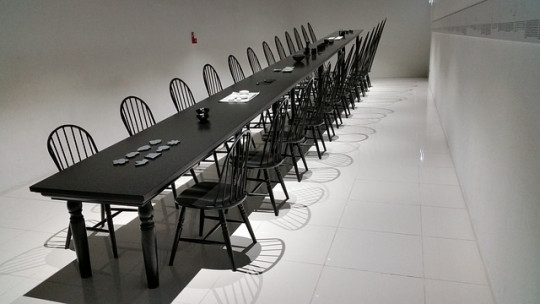
If we have suffered for something at Christmas, it has been because of the family lunches and dinners, one after another. For this reason, The center of all interactions at these parties is that table where we all gather we catch up, we eat, we laugh and we celebrate.
But not all tables are the same, nor are all the places around them. Spatial layout exerts different influences on people; in their level of participation and their nature. This is the object of study of environmental psychology and group psychology, disciplines that have detailed what effects your position at the table produces.
Types of arrangements in space
Regarding the variety of layouts in space, three classic ones are distinguished: the focused the sociofuge and the sociopet
1. Focused
All seats face a specific direction. With this provision Attention to a focus is enhanced and interaction between users is reduced ; participation is from the focus to the users and vice versa. This is the typical orientation of school classrooms, in which students are asked to listen to the teacher and not talk to each other.
2. Sociofuge
All seats face outwards. When arranged like this, users turn their backs on each other, so interpersonal communication is limited The little interaction that occurs in this arrangement tends to be at an intrapersonal level and directed at oneself. Although it is not common, sociofugal dispositions are used, for example in some currents of psychoanalysis in which the patient has his back to the psychotherapist, facilitating introspection.
3. Sociopets
All seats face inwards. This case is totally contrary; Users orient themselves to each other, facilitating interpersonal communication and leading it towards intragroupity It is essential for processes of trust and cohesion, due to the facilities it promotes for interaction and exchange. It is most typical in our society in group meetings, where the focus is the group itself.
Sociopetal Disposition: the most common in daily life
Now, of all these provisions, the one we encounter the most in our daily lives is the sociopetal
We all gather at tables to be with friends, family or at work meetings. This makes the sociopetal disposition the most influential in the areas of our lives and from which we can get the most benefit from knowing it. Within a sociopathic disposition, depending on where you are located, you do not participate in the same way, nor with whom. If orientation has its effects, so does geometry.
Square
A square table has four equal sides, so All people have the same option to speak to the group and it does not seem that there are big differences However, it does influence smaller relationships, in dyads or triads. People who sit next to each other, that is, in adjacent seats, tend to cooperate, provide mutual reinforcement, and agree. On the other hand, in opposite seats there is a tendency towards competition, favoring disagreements and questioning. Of course, in both one arrangement and another, there is a greater degree of interaction than if we sit in the corners.
Rectangular
In rectangular tables there are two narrower sides where the headboard effect occurs: occupying this position confers more status At the head there is not as much ease of communication as in the middle of the wide sides, since it limits visual contact and it is more difficult to be seen. However, when speaking, attention is more easily attracted, since the same lines of the table direct the gaze towards the headboard and provide the person as the focus. As for the broad sides, if someone is in the center, it is a sign that that person wants to get involved and interact. On the other hand, those in the corner prefer to stay on the sidelines, see what happens first and then they will intervene – or not. This facilitates the roles of participant and initiator in the center and observer and follower in the corners.
Circular
In circular arrangements the orientation of the seats does not change as drastically as in more rigid geometric shapes, such as square and rectangular. Because of that, the previous effects tend to decrease, for example, there is no location that denotes higher status, nor a place where one can take shelter, since everyone is equally exposed. However, there is the Steinzor effect, whereby one tends to interact to a greater degree with the people in front of one, due to having greater eye contact; so if you have something pending to say to someone, sit in front, they will help you.
Other environmental factors
Other environmental factors of group ecology may be temperature, which at high levels promotes irritability, or noise as a cause of stress. Even the same size of a room can influence the number of people, since having five is not the same as holding the meeting in a large room or in a small room. But of all of them, The most controllable is where we sit and, who knows, we may want to change places for next Christmas








